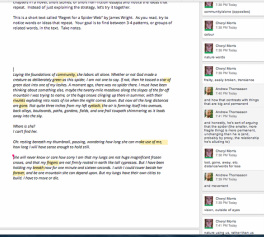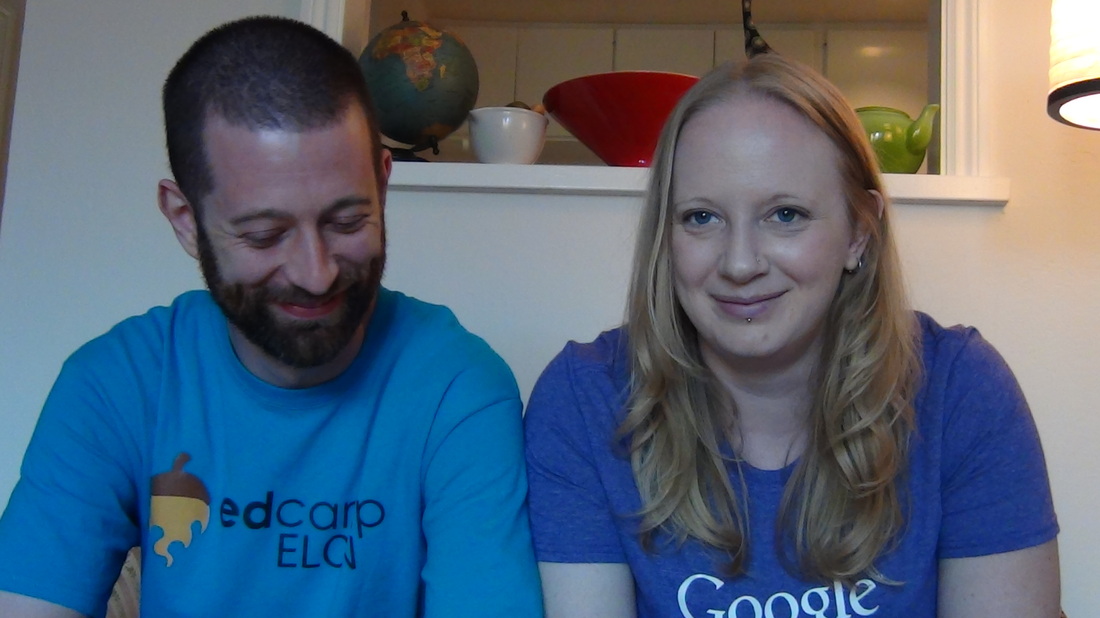Essentially, what we are saying to all our other students is that it is not worth it to teach you the art of writing because you didn’t sign up for a separate writing course.
But even worse, for the students in “regular” English, we turn writing into a science, a formula, and train them to plug in values until they’ve finished the required five paragraphs. You know what we’re REALLY teaching them? That writing is difficult, boring and completely irrelevant. If they are lucky, they will leave high school with the belief that writing is a drudgery undertaken because the alternative is getting an F.
Actually, there is something worse: thinking that because you can churn out a five paragraph essay, you are a good writer. Those students get a harsh awakening in their first college course. It’s just a guess, but I would bet that there is a large percentage of college drop-outs who could trace the reason they left back to their lack of ability in writing and their gradual awakening to the truth that what they learned in high school was nowhere near good enough outside of high school English class.
So what’s the alternative?
Teaching students to read like writers.
In the last post, I talked about a close reading strategy we use called patterning. It takes a text and breaks it into objective pieces so the reader can analyse the rhetorical structure and the underlying meaning. But another way we use the patterning strategy is to just look for general patterns in a text instead of looking for patterns in parts of speech and with the connotations of words. I tell students to just notice words or ideas that repeat and note them as they go.
Instead of just explaining the strategy, I’d like to model it for you. And you get to play along at home. This is a short text called “Regret for a Spider Web” by James Wright. As you read, try to notice words or ideas that repeat. Your goal is to find between 3-4 patterns, or groups of related words, in the text. If you’d like, you can actually comment on the text itself and we can make this document sort of a giant internet close read.
Ready? Don’t click Read More until you have done this for yourself, and ideally, commented on the document linked above. Trust us: it’s way more fun that way.

So here are the steps we ask students to go through to read a text like a writer:
- Ask them to find patterns and note how they are grouped together
- Tell the literal story of the text (like, what is the plot?)
- Ask them to find the ways in which the patterns are connected
- Develop what the author’s main point in writing is, based on the story and the patterns
- Ask: How is the author using patterns to develop the main idea and build meaning?
So here are the examples we worked out:
1. The pattern groups we found are:
- community vs alone
- colours - move from green to white
- movement/loss/gone/distance - move from summer to winter
- frailty, transience vs permanence/stability and largeness
- body parts contrasted with natural bodies
- a greater power than we can contradict has thwarted us (we are not in control)
2. What is the literal story?
The author is being used by a spider as a post for her house, and he knows that if he gets up, he will destroy it, but he can’t stay there forever.
3. How are the patterns connected?
Everything is about movement - the colours move from green to white, seasons turn from summer to winter, the leaves change and the snow is melting - more specifically, it’s about things that move that we don’t want to move. We don’t want winter to come, or instability to replace stability, or to feel out of control.
4. The author’s main point:
The writer is feeling the loss of all of those things, and one can infer that the reason this spiderweb registers is that he is going through a loss of his own - one that he can no more control than the changing of the seasons.
5. How does the author develop that main idea in this text?
In this case, the author builds tension and sets up the idea that he is undergoing a change in life by using extreme opposites to describe the world around him. The contrast between things that are permanent and stable and things that are fleeting and transient mirrors the author’s own internal state: he wants to stay and let the spider build her web, but he also knows that not moving is dying. That choice - a difficult one between life and death, even - forms the underlying meaning.
One way people deal with circumstances beyond our control is to abdicate one’s own sense of agency to “fate” or “God.” The author is not questioning the existence of God, but rather, is this God someone who I can trust to give me good things, or is He someone who will subject me to more misery? In that way, this short piece gets to one of the fundamental themes in human existence: why do bad things happen, and why can’t I stop them from happening? How do I survive all this pain and suffering? Is there meaning in pain? Is there a way out of the labyrinth of suffering?
******
From there, you can have a student write about the theme, or about how the author develops that theme using the patterns in the text, or even have them write their own experiences with feeling out of control. They can also use this as a model text to write their own short observational essay about any theme or idea they mined from the text.
The point is this: when you read like a writer, you end up examining the text both as a whole and in pieces. The process gives you TONS of ideas to explore, but the ideas will change based on the students in the room, the time of day and the mood in class. The beautiful thing about writing is that it gives you multiple pathways to talk about the themes that humans have explored for as long as we have written record. Patterning gives students the tools to find how great writers build implicit themes, and then it teaches them to wield the tools themselves in order to improve their own writing.
Redefining what “good writing” is takes work. This is another place where growth mindset comes into play; if students believe that good writing can come out of hard work rather than innate talent, then reading like a writer is an explicit step on their journey to being a good writer. Every time they read a piece, they are adding to their writer’s toolbox and taking one more step away from the mediocre writing they’ve been taught was the “right way” to write in high school English.
Our job is to help them take those steps, then to get out of the way and let them practice. That’s where “real writing” comes from: good models, a developed toolkit, a mentor who can point the way, and lots and lots of practice.
This is the third in a series of posts on the writing process. This post outlines our take on the five paragraph essay, this one discusses authentic feedback to student writing, and this one talks about patterning and how leading with ideas can produce better writing than thesis-driven essays.


 RSS Feed
RSS Feed
